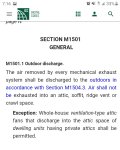oldsparky52
Senior Member
- Location
- Wilmington, NC USA
I have never gotten around to replacing the non vented bathroom fans that were originally installed in my home. I was talking to a friend of mine discussing how I would do it (after I lost some weight) and how much I hated the idea and process of doing it.
Anyway, the discussion of venting came up and he was of the opinion that pointing the vent duct to the ridge vent would be fine. I know that's what a lot of people did in the early 70's, but ... IDK. My buddy (who is pretty sharp) said there would not be enough moisture to be a problem. I'm a little dubious about this since this practice was banned (where I worked) in the mid 70's.
I am soliciting comments/opinions on whether it is okay to just run the vent duct to the ridge vent of the roof, or am I asking for trouble if I do this?
Anyway, the discussion of venting came up and he was of the opinion that pointing the vent duct to the ridge vent would be fine. I know that's what a lot of people did in the early 70's, but ... IDK. My buddy (who is pretty sharp) said there would not be enough moisture to be a problem. I'm a little dubious about this since this practice was banned (where I worked) in the mid 70's.
I am soliciting comments/opinions on whether it is okay to just run the vent duct to the ridge vent of the roof, or am I asking for trouble if I do this?

